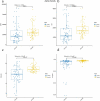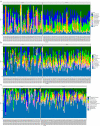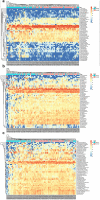The gut microbial diversity of colon cancer patients and the clinical significance
- PMID: 34551683
- PMCID: PMC8806656
- DOI: 10.1080/21655979.2021.1972077
The gut microbial diversity of colon cancer patients and the clinical significance
Abstract
The microbial diversity and communities in the excrement of healthy and patients suffered from cancer were identified by 16SrDNA sequencing performed on the Illumina Hi Seq sequencing platform. The microbial difference was also analyzed. The sequencing results showed high quality of the data, and the microbial communities were more various in the excrement of cancer patients. And the abundance of Firmicutes phylum was significantly reduced in cancer group. The phylum of Fermicutes, Bacteroidetes in cancer group are significantly down-regulated and up-regulated compared with normal group. The species of Faecalibacterium prausnitzii, Bateroides vulgatus and Fusicatenibacter saccharivorans are significantly lower in cancer group than that in normal group (P< 0.05). The species of Prevetella copri, M. uniformis, and Escherichia coli are significantly higher in the cancer group than that in normal group. The comparative results indicated that beneficial bacterium significantly decreased in colorectal cancer (CRC) group, and harmful bacterium significantly increased in the colon cancer group, meanwhile the acidity, sugar increased whereas the oxygen content decreased to facilitate the growth of harmful bacterium. The results would provide microbial approaches for the treatment of colon cancer by the intake of beneficial microbial communities.
Keywords: Colon cancer; beneficial bacteria; harmful bacteria; microbial diversity.
Conflict of interest statement
No potential conflict of interest was reported by the author(s).
Figures






References
-
- Hooper LV, Gordin JI.. Commensal host-bacterial relationships in the gut[J]. Science. 2001;292:1115–1118. - PubMed
-
- Zijlmans MA, Korpela K, Riksen-Walraven JM, et al. Maternal prenatal stress is associated with the infant intestinal microbiota[J]. Psychoneuroendocrinology. 2015;53:233–245. - PubMed
-
- Van Daele E, Knol J, Belzer C.. Microbial transmission from mother to child: improving infant intestinal microbiota development by identifying the obstacles[J]. Crit Rev Microbiol. 2019;45(5/6):613–648. - PubMed
MeSH terms
Substances
LinkOut - more resources
Full Text Sources
Other Literature Sources
